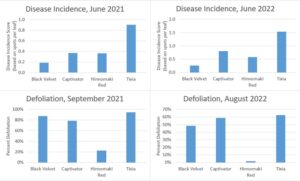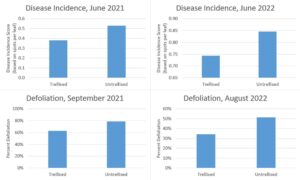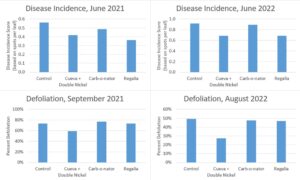Final report for FNC21-1290
Project Information
Chris & Juli McGuire have operated Two Onion Farm since 2003. We initially raised mixed vegetables, but began transitioning from vegetable to fruit production in 2012. We currently raise 2.5 acres of apples, one-quarter acre of currants, and one-quarter acre of gooseberries. All our farm products are certified organic. We transitioned our farm from vegetables to fruit to meet a strong market demand for local organic fruit and to protect our hillside soils from erosion with perennial crops.
We market our fresh fruit and value-added products through a community-supported agriculture (CSA) program, to local grocery stores and chefs, and to other farms in our region for resale to their customers. We strive to make our produce available to everyone in our community: we sell our fruit at low price to area food pantries and we raise funds from our CSA members to subsidize the cost of CSA memberships for low-income households.
We aim for crop production methods that produce high yields while preserving the environment. We mulch under our fruit crops to reduce weed competition, supply nutrients and organic matter, and nourish beneficial soil fungi. We use drip irrigation to conserve water while producing high yields. Insect pest and disease management can be extremely challenging in organic fruit production. Where possible, we grow disease resistant varieties and use cultural techniques such as sanitation and pruning to reduce disease. We encourage beneficial insects, scout daily for pests, monitor weather to predict pest outbreaks, and only spray organic pesticides as a last resort.
Our farm infrastructure includes a packing shed with walk-in coolers, and two tractors with implements for tillage, cultivation, mowing, spraying, and spreading amendments.
Although gooseberries are not a common food in our region, they are a promising new crop which produces a flavorful fruit suited for fresh eating and processing. Along with other organic fruit farmers in the region, we have grown gooseberries but found that the Anthracnose leaf spot disease is extremely devastating: it defoliates plants by mid-late summer in most years, increases over the years as a planting ages, and appears to greatly reduce plant vigor and yield. We have observed that varieties differ in susceptibility and that trellising the plants may lessen the severity of the disease, but we have not found a truly effective organic control that is environmentally benign and effective. Over two growing seasons, we have measured the effects of several factors on disease severity:
- Gooseberry variety
- Training method (freestanding bush vs. cordon trellis)
- Organic spray regimen (potassium bicarbonate, copper soap plus Bacillus amyloliquefaciens, Reynoutria sachalinensis extract, and no sprays)
We studied multiple factors because it is likely that a combination of all three factors may be required for effective control.
Main conclusions from our research are that gooseberry varieties vary dramatically in susceptibility to Anthracnose, trellising marginally reduces the diseases, and that sprays of copper soap plus Bacillus amyloliquefaciens or Reynoutria sachalinensis extract reduce the disease. We disseminated these results extensively through online webinars, a field day at our farm, publications in regional and national periodicals, email list servs, an online discussion group and an email newsletter.
1. Measure the susceptibility of four common gooseberry varieties to Anthracnose leaf spot.
2. Measure the effect of training method (cordon trellis or freestanding bush) on Anthracnose incidence.
3. Measure the effect of three organic sprays on Anthracnose incidence, compared to an unsprayed control.
4. Share findings through conference presentations, written reports, and an online video.
Research
We conducted this research in an existing 1/4 acre gooseberry planting with four 288' rows spaced 10' apart. This planting was established as part of an on-farm research project to compare the effects of two training methods (cordon trellis and freestanding bush) on yield, labor, and profitability in four common varieties (Black Velvet, Hinnomaki Red, Tixia, and Captivator). The planting was laid out in a randomized complete block design. Each row is divided into 12 plots, each 24' long (48 plots total). Each plot contains one variety grown with one training method; each combination of variety and training method is replicated six times. Because the planting contains a randomized arrangement of training methods and varieties, it provides an excellent opportunity to analyze the effects of these factors on disease.
A complete description of the cordon trellis training method practiced in this project is available online. Briefly, in the cordon trellis method, each gooseberry plant is trained to a single permanent vertical stem (the cordon). Fruit is produced on horizontal branches from the cordon, and these branches are pruned back annually after fruiting. This method produces an open canopy which is easy to harvest from and which may reduce disease.
To evaluate the effects of organically approved spray treatments in the current project, we used a split-plot design and divided existing 24' plots into 4 sub-plots, each 6' long. In each plot, the four sub-plots were randomly assigned to one of four spray treatments:
- Regalia (Reynoutria sachalinensis extract) (2 quarts/50 gallons spray solution). In the first two spray applications in 2020, we tank mixed the Regalia with JMS Stylet Oil (horticultural oil) (2 quarts/50 gallons) but thereafter we omitted the oil because we saw severe phytotoxicity in the variety Captivator (leaf cupping and bronzing followed by rapid defoliation). We saw no phytotoxic reaction when the Regalia was sprayed alone.
- Carb-o-nator (potassium bicarbonate) (2.5 lb/50 gallons)
- Mix of Cueva (copper soap) (2 gallons/50 gallons) and Double Nickel (Bacillus amyloliquefaciens) (1 lb/50 gallons)
- Unsprayed control
These products are preventative, not curative, and Anthracnose infection occurs repeatedly during the growing season. Therefore we sprayed at approximately 10 day intervals from May-September. Specific spray dates in 2021 were 4/23, 4/30, 5/11, 5/22, 5/31, 6/11, 6/22, 7/3, 7/13, 7/23, and 8/2. The first spray on 4/23 was made when the earliest flowering variety in our study (Black Velvet) was in early bloom. In 2022, sprays were made on 5/2, 5/10, 5/24, 6/7, 6/17, 6/27, and 7/18. In 2022, bloom started on 5/7, so sprays were begun 5 days before bloom.
All spray products have been approved by our organic certifier and are labeled for use on gooseberries. Tank mixes and spray rates were based on label guidelines and manufacturer recommendations. To avoid spray drift between adjacent plots, we sprayed by hand with a motorized backpack sprayer (Stihl model SR200) in calm weather.
In June of each year (on 6/10/2021 and on 6/28/2022) we collected data from two shoots on 1 plant in each sub-plot. One of the two shoots was a vertical stem (the cordon on trellised plants or a strong vertical shoot on untrellised plants) and the other shoot was a horizontal branch originating near 6" above ground. We purposefully selected shoots not growing near the edges of the sub-plot to avoid ones which may have experienced spray drift. On each stem we graded disease severity on each leaf growing on current year's growth. Disease severity was graded on the following scale: D=leaf no longer present, 0=no Anthracnose leaf spots, 1=leaf spots present but covering <1% of the leaf, 2=spots covering 1-5% of the leaf, and 3=spots covering >5% of the leaf. Few leaves were graded as "Not present" on this date, and analysis showed no difference between treatments in percent of leaves not present. Ignoring leaves not present, we calculated an average disease severity over all leaves for each shoot.
In late summer, (on 9/8/2021 and on 8/8/2022) we again collected data from one vertical shoot and one horizontal shoot per sub-plot, selected according to the same criteria as above. On this date virtually all leaves had leaf spots covering >5% of the leaf and we did not collect data on disease severity. However many leaves had dropped from the plants by this data, and Anthracnose causes premature defoliation. Therefore we counted the number of leaves which had dropped from each stem and the number of remaining leaves and calculated a percent of leaves defoliated for each shoot.
Only one variety, Captivator, yielded significantly in 2021. In 2022, three varieties, Black Velvet, Captivator, and Hinnomaki Red yielded significantly. We measured the yield separately in each sub-plot.
Statistical analysis was performed by Leslie Holland, UW-Madison Department of Plant Pathology. Separate ANOVA analyses were conducted for each of nine response variables:
• Mean June disease severity for low shoots in June 2021
• Mean June disease severity for high shoots in June 2021
• Mean June disease severity for low shoots in June 2022
• Mean June disease severity for low shoots in June 2022
• Mean percent defoliation for low shoots in late season 2021
• Mean percent defoliation for high shoots in late season 2021
• Mean percent defoliation for low shoots in late season 2022
• Mean percent defoliation for high shoots in late season 2022
• Mean yield per sub-plot, measured in half-pints, in 2022
Block, variety, spray treatment, trellising method were included as independent variables in each analysis along with the interactions variety x spray treatment, variety x trellising method, spray treatment x trellising method, and variety x spray treatment x trellising method.
First Anthracnose symptoms were observed in late May of each year (on 5/21/21 and on 5/30/22), and symptoms developed throughout the season, particularly after wet weather. Defoliation of infected leaves was observed from early June onward. The first defoliation was on fruit-bearing spurs; current year's extension shoots did not defoliate significantly before July and August.
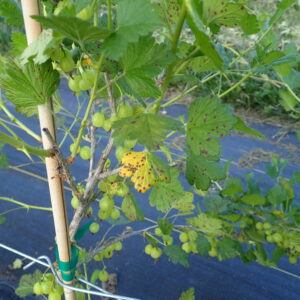
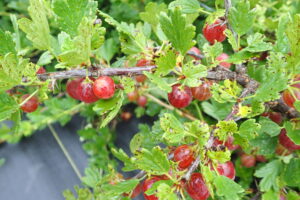
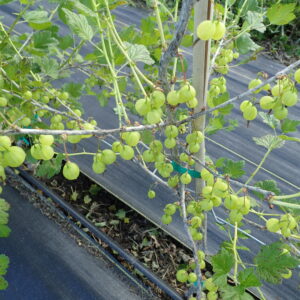
Overall Summary of Treatment Effects.
Varieties showed clear, obvious differences in both disease incidence and defoliation. From most resistant to most susceptible, the varieties were:
- Hinnomaki Red was most resistant. In particular, it suffered astonishingly little late-season defoliation compared to the other three varieties.
- Black Velvet showed similar disease resistance to Hinnomaki Red in June, but then suffered moderate late season defoliation.
- Captivator was intermediate in both June disease incidence and late season defoliation
- Tixia was clearly most susceptible to both June disease and late season defoliation.
Trellising reduced June disease incidence and defoliation on high shoots, but not on low- growing shoots. However, the effects of trellising were slight and often varied by variety and/or spray method.
Cueva + Double Nickel and Regalia sprays both reduced disease in June, but only Cueva + Double Nickel sprays reduced late season defoliation. Differences among spray treatments were pronounced and visually obvious.
In 2021, Captivator was the only variety to produce measurable yield. In 2022, yields of Captivator were much higher (approximately 120,000 half-pints per acre) than Hinnomaki Red (40,000 half-pints per acre), which was in turn higher than Black Velvet (approximately 12,000 half-pints per acre). Tixia again failed to produce significant yield. Captivator blooms and sets fruit heavily on large-sized plants. Black Velvet is a large bush and blooms heavily, but has failed to set heavy crops of fruit on our farm for unknown reasons. Hinnomaki Red is a small plant, although it set a dense crop of berries in 2022. In addition, the Cueva + Double Nickel spray treatment increased yield in the variety Captivator.
Detailed results of statistical analyses for each response variable are available online at: https://www.twoonionfarm.com/WebsiteReportAnthracnoseLeafSpotGooseberry.pdf
Educational & Outreach Activities
Participation Summary:
On July 15, 2021, we shared preliminary results from this project in a webinar as part of the University of Wisconsin Cooperative Extension Emerging Crops Webinar Series, aimed primarily at extension agents, researchers, and other agricultural professionals. I co-presented with farmer Clare Hintz from Elsewhere Farm (Herbster, WI) on gooseberry and currant production, including a discussion of Anthracnose Leaf Spot and this study. A link to the powerpoint presentation accompanying my portion of the webinar presentation is here: Emerging Crops Ribes Webinar July 2021
On December 17, 2021, we shared preliminary results from this project in a webinar sponsored by the Savanna Institute. I presented on the Cordon Trellis method for growing currants and gooseberries, including a discussion of Anthracnose Leaf Spot and this study. Approximately 25 attendees (a mix of current and aspiring farmers and agricultural professionals) viewed the webinar live, and the Savanna Institute also recorded the webinar and it is available online. The online recording has received 3400+ views.
In August 2021, University of Wisconsin fruit crop pathologist Leslie Holland visited our farm, toured our research plot, and discussed project results in August, 2021.
- In 2023, we submitted press releases summarizing project results to several regional and national farming publications. As a result, several articles have been or will bepublished:
- An article in Agri-View, a regional farming newspaper, on May 31, 2023 Gooseberry-disease controls tested
- An article in Just Picked, the newsletter of the Organic Fruit Growers Association, Organic Management of Anthracnose Leaf Spot in Gooseberries.
- An article in Wisconsin Fruit News, the newsletter of the UW Extension fruit crops program, Organic Management of Anthracnose Leaf Spot in Gooseberries.
- A two page article in Fruit Growers News, a national commercial fruit growing periodical, July 2023 issue, entitled "What's Good For the Gooseberry..."
- An upcoming article in the Organic Broadcaster.
On June 28, 2023, we hosted a field day at our farm co-sponsored by the UW Emerging Crops program and Marbleseed. Fourty-four participants attended, a mix of current and aspiring farmers and agriculture professionals. We discussed results from this project at the field day.
We posted a summary of project results and links to the online publication and video in the following list-servs, email newsletters, and online discussion groups:
- Holistic Orchard Network
- Fairshare google group (437 subscribers)
- Organic fruit growers google group (152 subscribers)
- The Practical Farmers of Iowa horticulture list serv
- Angelic Organics Learning Center CRAFT bi weekly broadcast
We have published a detailed description of project results on our website (29 downloads to date) and we have posted an online video on YouTube highlighting key results (26 views to date).
We did not present project results at conferences as originally planned, partially because conference formats changed in recent years and partially because results of statistical analyses were not available in time. To compensate, however, we did share results at a field day and in two online webinars, venues which were not planned in the original project proposal.
Learning Outcomes
This study did not reveal any methods of Anthracnose Leaf Spot control which were completely effective at eliminating the disease. Anthracnose symptoms occurred in all experimental treatments. However, we found clear and consistent evidence that variety selection, trellising, and organic sprays can all provide some control of Anthracnose.
Varieties differ enormously in their susceptibility to Anthracnose. Hinnomaki Red stood out in this study for its exceptional resistance, and Tixia was notable for extreme susceptibility. It would be worthwhile to test additional varieties for their resistance and susceptibility. However, commercial growers need to consider other factors such as yield and flavor in their variety selection. For example, growers may prefer Captivator to Hinnomaki Red, because Captivator is much higher yielding, despite its greater disease susceptibility.
Trellising slightly decreases disease severity. However, we have found that trellising is very expensive in materials and labor: trellised plantings incur about $15,000 per acre in additional costs during establishment for trellis materials and plants, and roughly 200 hours per acre in additional labor in the first two years of the planting for trellis construction, planting, and training plants (see www.twoonionfarm.com/research/). Therefore we expect that few growers would adopt trellising for disease control alone, but that other possible benefits of trellising such as improved fruit quality and/or faster harvest would drive this decision.
Sprays of Cueva and Double Nickel reduced Anthracnose Leaf Spot, decreased defoliation, and also increased yield of Captivator in 2022. It would be interesting to know whether Cueva or Double Nickel sprayed alone would also control Anthracnose. Cueva is a copper-based product and many growers have reservations about spraying copper because of possible environmental and health impacts. Regalia is a more environmentally benign alternative; Regalia sprays decreased early season disease but did not affect late season defoliation. Carb-o-nator probably absolutely no control of Anthracnose in this experiment.
